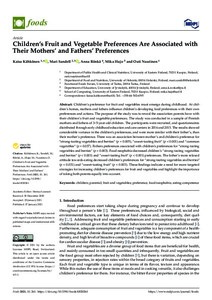Children's Fruit and Vegetable Preferences Are Associated with Their Mothers' and Fathers' Preferences
Nuutinen Outi; Ronka Anna; Hujo Mika; Sandell Mari; Kähkönen Kaisa
Children's Fruit and Vegetable Preferences Are Associated with Their Mothers' and Fathers' Preferences
Nuutinen Outi
Ronka Anna
Hujo Mika
Sandell Mari
Kähkönen Kaisa
MDPI
Julkaisun pysyvä osoite on:
https://urn.fi/URN:NBN:fi-fe2021042822663
https://urn.fi/URN:NBN:fi-fe2021042822663
Tiivistelmä
Children's preference for fruit and vegetables must emerge during childhood. At children's homes, mothers and fathers influence children's developing food preferences with their own preferences and actions. The purpose of the study was to reveal the association parents have with their children's fruit and vegetable preferences. The study was conducted in a sample of Finnish mothers and fathers of 3-5-year-old children. The participants were recruited, and questionnaires distributed through early childhood education and care centers in 2014 and 2015. The results showed considerable variance in the children's preferences, and were more similar with their father's, than their mother's preference. There was an association between mother's and children's preference for "strong-tasting vegetables and berries" (p = 0.005), "sweet-tasting fruit" (p < 0.001) and "common vegetables" (p = 0.037). Fathers preferences associated with children's preferences for "strong-tasting vegetables and berries" (p = 0.003). Food neophobia decreased children's "strong-tasting vegetables and berries" (p < 0.001) and "sweet-tasting fruit" (p < 0.001) preferences. The father's more relaxed attitude towards eating decreased children's preferences for "strong-tasting vegetables and berries" (p = 0.031) and "sweet-tasting fruit" (p = 0.003). These findings indicate a need for more targeted strategies for increasing children's preferences for fruit and vegetables and highlight the importance of taking both parents equally into account.
Kokoelmat
- Rinnakkaistallenteet [19207]
